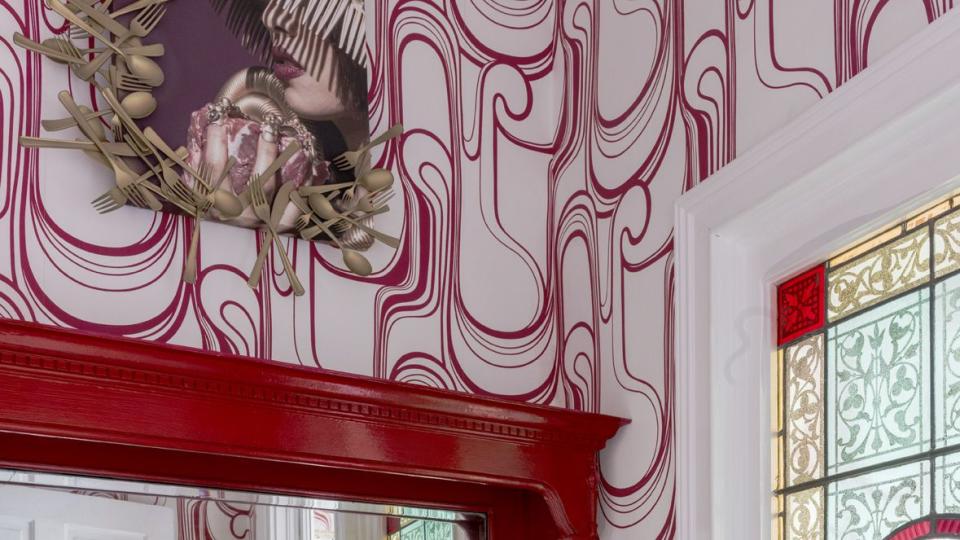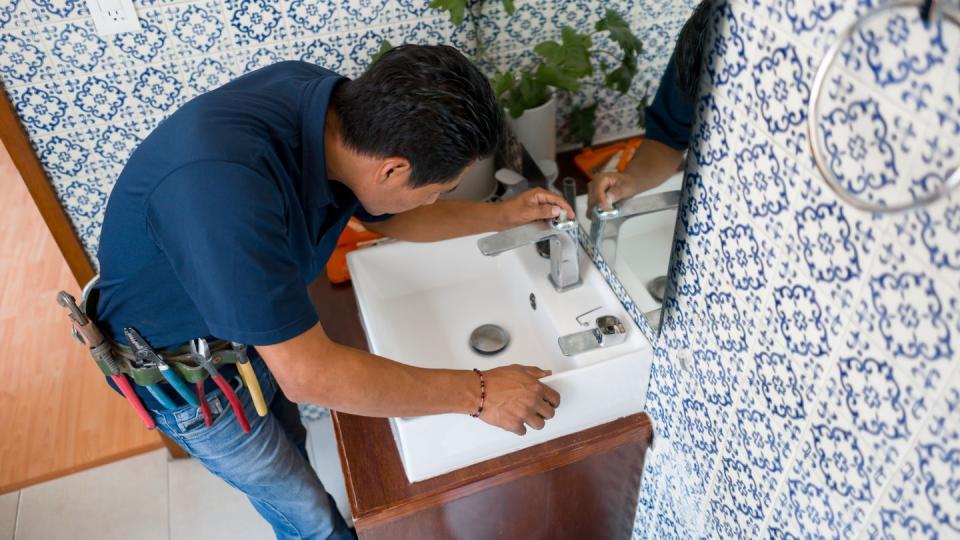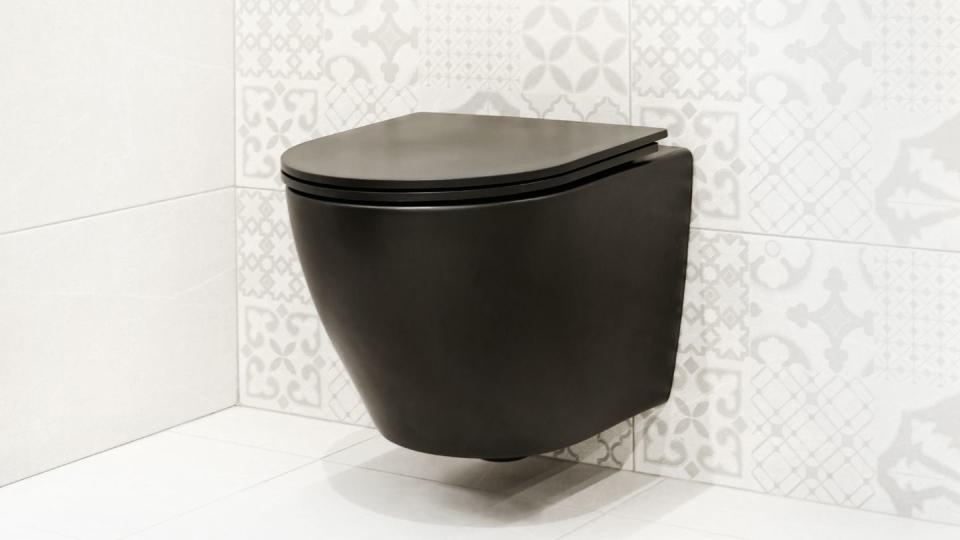Joanna Gaines's Favorite Bathroom Trick is Apparently a NIGHTMARE, According to Plumbers
It's an Instagram staple: antique dressers, tables, sewing machines and so on that have been turned into one-of-a-kind bathroom vanities. Even Joanna Gaines has championed the trend, transforming an antique table into an enviable sink for Fixer Upper. Home reno TV shows and YouTubers, like the Nifty Nester, make the transformation look easy. So easy, that you might be tempted to give new life to your own vintage pieces, or even search a salvage yard for inspo.

It's not just DIY-ers. Interior designers like Lucinda Loya love to upcycle, too. For a project, the Houston-based pro once took a Victorian-era cabinet and infused it with life, and candy-apple red hue. "The unique piece was an original fixture in the home, complemented by the integrated Corian sinks that not only amplify its functionality but also add to its overall allure," she says of the piece, which reflected the character of the Italianate architecture of the house.
But before you start cutting holes out of old dressers to turn them into sinks, take some advice from the experts—not designers, in this case, but plumbers. We asked them, how easy is it to upcycle furniture when plumbing is involved?
The Plumbers' Point of View
Josh Mitchell, plumbing expert and owner at Plumbing Lab in Sydney, Australia, has certainly noticed an uptick in requests to convert dressers into bathroom vanities. "While it's not a daily occurrence, it has definitely become more frequent, especially among those looking to add a unique or vintage flair to their bathrooms" Mitchell says. "I find myself working on such projects a handful of times each year, often after clients have been inspired by design websites or home renovation shows." Stateside, Rich Mullins, plumbing expert and owner of H2O Plumbing in Corydon, Indiana, agrees that the request "is becoming increasingly popular as homeowners seek unique and customized solutions that add character to the bathroom."
But while turning a dresser into a sink may be popular, it's not an entry level project for plumbing newbies. "Dressers aren't designed for plumbing, so you need to modify the dresser to accommodate the sink, drain, and water supply lines," says James Lawrence, owner of Lawrence Remodeling Co. in Shaker Heights, Ohio. "This may require cutting holes in the dresser and ensuring proper connections, which can be complex and time-consuming."

One of the most common issues that Mullins faces in this type of project is ensuring proper plumbing alignment. "This can involve cutting holes in the back of the dresser to accommodate pipes and making sure that the sink and faucet are securely attached," he says.
While the projects aren't too difficult for someone who knows what they are doing, they do demand precision and careful planning. Mitchell says that one of the biggest challenges is housing the plumbing without weakening the overall framework and the internal structure of the dresser. "This often means altering drawers or internal compartments," he explains. "When it comes to installation time, these custom conversions tend to be more time-consuming than standard vanity installations. Whereas I can set up a pre-made vanity in a few hours, a dresser conversion can sometimes span an entire day or more, given the specific challenges that might arise."
That means that if you're paying a plumber, this can be a pricey job. On the other hand, before you think of DIY-ing Mitchell points out that this is the type endeavor that requires a thorough understanding of plumbing and carpentry–not only do you have to get the pipe connections right, but the new bathroom vanity can't just be a pretty piece of furniture, it has to function and retain at least some storage.
If you feel you're up to the task, here's what you need to do to transform a dresser into a bathroom vanity with sink:
Consider the Cost
Sure, you may have a free dresser and you can find a cheap sink, but if you're not especially handy, contracting an expert to make the modification can end up costing more than it would be to buy a premade vanity, Lawrence points out. A plumber can charge between $45 to $200 per hour and you may have to find a carpenter, who charges between $250 to $850 per project, to do the woodwork.
Look at the Dimensions
The dresser's dimensions may not align with standard vanity sizes most sinks fit, or with the space you have. "The standard vanity height is around three feet tall," says Mike Grijavalva, a journeyman plumber and business owner of Sacramento Plumbing Solutions. You might need to adjust the dresser's height, width, or depth to accommodate the sink and ensure comfortable use, Lawrence notes.
Rework the Drawers
Even if your furniture piece looks like it fits into the bathroom space, you may still need to do plumbing adjustments, especially for the drain and water supply lines. "It's like navigating through Narnia sometimes," says John Melby, plumbing expert at Vancouver Plumbing Services. "The depth of the drawers tends to play hide and seek with the plumbing. It’s a cheeky game of adjustment and compromise, but, with a bit of creativity." Mitchell adds that this setup often demands a comprehensive understanding of plumbing systems to ensure no leaks and proper functionality.
Check That the "Vanity" is Sturdy
Dressers are generally not structurally strong enough to support the weight of a sink, countertop, and plumbing fixtures. Reinforcements may be necessary to prevent sagging or collapsing, Lawrence adds.
Ensure the Sink Will Drain Properly
For Mullins, one of the primary concerns when repurposing furniture for a vanity is ensuring proper drainage. "To tackle this challenge effectively, you'll need to create an opening for the drainpipe and ensure that it slopes correctly to prevent water from pooling," he says. "Poor drainage can lead to a host of issues, including stagnant water and potential damage to the furniture."
Prep Your Power Towels
Converting a dresser into a vanity calls for accurate measurements and power tools to cut through the furniture. "The top of the dresser will require precise cuts for the sink and faucet," Mitchell says. "Using the right tools, like a hole saw for the faucet and a jigsaw for the sink, is essential. Precision is key to avoid damaging the furniture or ending up with misaligned fixtures." Expect more work if you're dealing with drawers instead of cabinet doors. "Drawers and storage space may need to be sacrificed," Lawrence adds.
Waterproof the Dresser
Most dressers and cabinets are not made to handle moisture. "A waterproof sealant should be applied to protect the wood and extend the vanity's lifespan," Mitchell says.
4 More Design-inspired Bathroom Projects That Can Be a Challenge

For Mitchell, and our other experts, plumbing isn't just about functionality; there has to be a balance between aesthetics with practicality. Here, four more design-focused bathroom installs that always keep him on his toes.
Wall-mounted Toilets, Vanities, and Faucets
They look incredibly sleek, but they often require Mitchell to think creatively to keep plumbing concealed while ensuring it remains accessible for any future repairs.
Freestanding Bathtubs
These can be a puzzle, particularly when it comes to their drain and overflow systems, especially if someone wants them situated away from the usual plumbing setups.
Open Shower Concepts
Mitchell loves how they look, but they always make him double-check drain placements to ensure water doesn't venture into unwanted areas of the bathroom.
Reclaimed Industrial Fixtures
Repurposing old industrial taps or other fixtures for home use has its set of challenges, given they weren't originally designed for residential settings.
You Might Also Like

